Creating Custom Widget Extensions
|
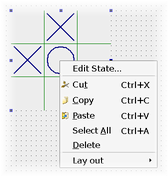 | QDesignerTaskMenuExtension QDesignerTaskMenuExtension provides an extension that allows you to add custom menu entries to Qt Designer's task menu. See also the Task Menu Extension example. |
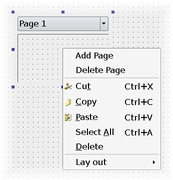 | QDesignerContainerExtension QDesignerContainerExtension provides an extension that allows you to add (and delete) pages to a multi-page container plugin in Qt Designer. See also the Container Extension example. Note: It is not possible to add custom per-page properties to certain widgets (e.g., QTabWidget) due to the way they are implemented. This limitation will be addressed in future versions of Qt. |
The usage of QDesignerMemberSheetExtension and QDesignerPropertySheetExtension is more rare, but the classes enables you to manipulate the appearance of class members within Qt Designer's workspace.
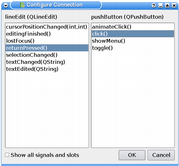 | QDesignerMemberSheetExtension The QDesignerMemberSheetExtension class allows you to manipulate a widget's member functions displayed when connecting signals and slots. |
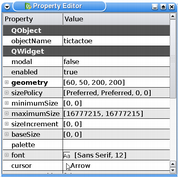 | QDesignerPropertySheetExtension, QDesignerDynamicPropertySheetExtension These extension classes allow you to manipulate a widget's properties displayed in Qt Designer's property editor. |
| QDesignerScriptExtension The QDesignerScriptExtension class allows you to define script snippets that are executed when a form is loaded. The extension is primarily intended to be used to set up the internal states of custom widgets. |
Qt Designer uses the QDesignerPropertySheetExtension and the QDesignerMemberSheetExtension classes to feed its property and signal and slot editors. Whenever a widget is selected in its workspace, Qt Designer will query for the widget's property sheet extension, and whenever a connection between two widgets is requested, Qt Designer will query for the widgets' member sheet extensions.
Warning: All widgets have default property and member sheets. But if you implement custom property sheet or member sheet extensions, these extensions will override the default sheets.
Creating an Extension
To create an extension you must inherit both QObject and the appropriate base class, and reimplement its functions. Since we are implementing an interface, we must ensure that it's made known to the meta object system using the Q_INTERFACES() macro in the extension class's definition. For example:
class MyExtension: public QObject,
public QdesignerContainerExtension
{
Q_OBJECT
Q_INTERFACE(QDesignerContainerExtension)
...
}
This enables Qt Designer to use the qobject_cast() function to query for supported interfaces using nothing but a QObject pointer.
Exposing an Extension to Qt Designer
In Qt Designer the extensions are not created until they are required. For that reason, when implementing extensions, you must subclass QExtensionFactory to create a class that is able to make instances of your extensions. In addition you must register your factory with Qt Designer's extension manager; the extension manager controls the construction of extensions as they are required.
When an extension is requested, Qt Designer's extension manager will run through all its registered factories calling QExtensionFactory::createExtension() for each until it finds one that is able to create the requested extension for the selected widget. This factory will then make an instance of the extension.
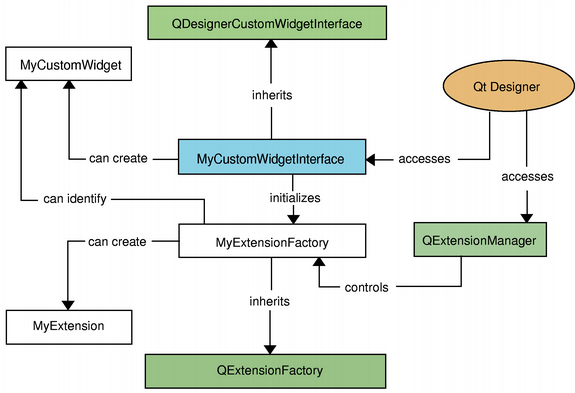
Creating an Extension Factory
The QExtensionFactory class provides a standard extension factory, but can also be used as an interface for custom extension factories. The purpose is to reimplement the QExtensionFactory::createExtension() function, making it able to create your extension, such as a MultiPageWidget container extension.
You can either create a new QExtensionFactory and reimplement the QExtensionFactory::createExtension() function:
QObject *ANewExtensionFactory::createExtension(QObject *object,
const QString &iid, QObject *parent) const
{
if (iid != Q_TYPEID(QDesignerContainerExtension))
return 0;
if (MyCustomWidget *widget = qobject_cast<MyCustomWidget*>
(object))
return new MyContainerExtension(widget, parent);
return 0;
}
or you can use an existing factory, expanding the QExtensionFactory::createExtension() function to enable the factory to create your custom extension as well:
QObject *AGeneralExtensionFactory::createExtension(QObject *object,
const QString &iid, QObject *parent) const
{
MyCustomWidget *widget = qobject_cast<MyCustomWidget*>(object);
if (widget && (iid == Q_TYPEID(QDesignerTaskMenuExtension))) {
return new MyTaskMenuExtension(widget, parent);
} else if (widget && (iid == Q_TYPEID(QDesignerContainerExtension))) {
return new MyContainerExtension(widget, parent);
} else {
return 0;
}
}
Accessing Qt Designer's Extension Manager
When implementing a custom widget plugin, you must subclass the QDesignerCustomWidgetInterface to expose your plugin to Qt Designer. This is covered in more detail in the Creating Custom Widgets for Qt Designer section. The registration of an extension factory is typically made in the QDesignerCustomWidgetInterface::initialize() function:
void MyPlugin::initialize(QDesignerFormEditorInterface *formEditor)
{
if (initialized)
return;
QExtensionManager *manager = formEditor->extensionManager();
Q_ASSERT(manager != 0);
manager->registerExtensions(new MyExtensionFactory(manager),
Q_TYPEID(QDesignerTaskMenuExtension));
initialized = true;
}
The formEditor parameter in the QDesignerCustomWidgetInterface::initialize() function is a pointer to Qt Designer's current QDesignerFormEditorInterface object. You must use the QDesignerFormEditorInterface::extensionManager() function to retrieve an interface to Qt Designer's extension manager. Then you use the QExtensionManager::registerExtensions() function to register your custom extension factory.
Related Examples
Please see the Task Menu Extension and Container Extension examples for more information about creating custom widget extensions in Qt Designer.
[Previous: Creating Custom Widgets for Qt Designer] [Contents] [Next: Qt Designer's UI File Format]
Best Of
Actualités les plus lues
- « Quelque chose ne va vraiment pas avec les développeurs "modernes" », un développeur à "l'ancienne" critique la multiplication des bibliothèques 64
- Créer des applications avec un style Metro avec Qt, exemples en QML et C++, un article du blog Digia traduit par Thibaut Cuvelier 0
- 2017 : un quinquennat pour une nouvelle version du C++ ? Possible, selon Herb Sutter 3
- Orientation de l'écran en QML, un article de Christophe Dumez traduit par Thibaut Cuvelier 0
- « Quelque chose ne va vraiment pas avec les développeurs "modernes" », un développeur à "l'ancienne" critique la multiplication des bibliothèques 64
- Apercevoir la troisième dimension ou l'utilisation multithreadée d'OpenGL dans Qt, un article des Qt Quarterly traduit par Guillaume Belz 0
- Les développeurs ignorent-ils trop les failles découvertes dans leur code ? Prenez-vous en compte les remarques des autres ? 17
- BlackBerry 10 : premières images du prochain OS de RIM qui devrait intégrer des widgets et des tuiles inspirées de Windows Phone 0
- Quelles nouveautés de C++11 Visual C++ doit-il rapidement intégrer ? Donnez-nous votre avis 10
- Adieu qmake, bienvenue qbs : Qt Building Suite, un outil déclaratif et extensible pour la compilation de projets Qt 17
- La rubrique Qt a besoin de vous ! 1

- Linus Torvalds : le "C++ est un langage horrible", en justifiant le choix du C pour le système de gestion de version Git 100
- Comment prendre en compte l'utilisateur dans vos applications ? Pour un développeur, « 90 % des utilisateurs sont des idiots » 229
- Quel est LE livre que tout développeur doit lire absolument ? Celui qui vous a le plus marqué et inspiré 96
- Apple cède et s'engage à payer des droits à Nokia, le conflit des brevets entre les deux firmes s'achève 158
- Nokia porte à nouveau plainte contre Apple pour violation de sept nouveaux brevets 158
- Quel est le code dont vous êtes le plus fier ? Pourquoi l'avez-vous écrit ? Et pourquoi vous a-t-il donné autant de satisfaction ? 83
- Le Draft final de la norme C++ 0X validé 181

Le blog Digia au hasard

Créer des applications avec un style Metro avec Qt, exemples en QML et C++, un article de Digia Qt traduit par Thibaut Cuvelier
Communauté
Ressources
- 91 cours et tutoriels Qt
- F.A.Q. Qt : 200 questions et réponses
- 48 Qt Quarterly, 35 Qt Labs et 22 Qt DevNet en français
- 43 outils Qt
- 99 sources Qt
- 26 binaires Qt
- 6 livres Qt et 9 critiques
- La documentation de Qt 4.7 en français : 157 classes, 70 concepts et 24 modules
- 3 certifications Qt
Liens utiles
Contact
- Vous souhaitez rejoindre la rédaction ou proposer un tutoriel, une traduction, une question... ? Postez dans le forum Contribuez ou contactez-nous par MP ou par email (voir en bas de page).
Qt dans le magazine
| Cette page est une traduction d'une page de la documentation de Qt, écrite par Nokia Corporation and/or its subsidiary(-ies). Les éventuels problèmes résultant d'une mauvaise traduction ne sont pas imputables à Nokia. | Qt qtextended4.4 | |
| Copyright © 2012 Developpez LLC. Tous droits réservés Developpez LLC. Aucune reproduction, même partielle, ne peut être faite de ce site et de l'ensemble de son contenu : textes, documents et images sans l'autorisation expresse de Developpez LLC. Sinon, vous encourez selon la loi jusqu'à 3 ans de prison et jusqu'à 300 000 E de dommages et intérêts. Cette page est déposée à la SACD. | ||
| Vous avez déniché une erreur ? Un bug ? Une redirection cassée ? Ou tout autre problème, quel qu'il soit ? Ou bien vous désirez participer à ce projet de traduction ? N'hésitez pas à nous contacter ou par MP ! | ||
Copyright © 2000-2012 - www.developpez.com



















